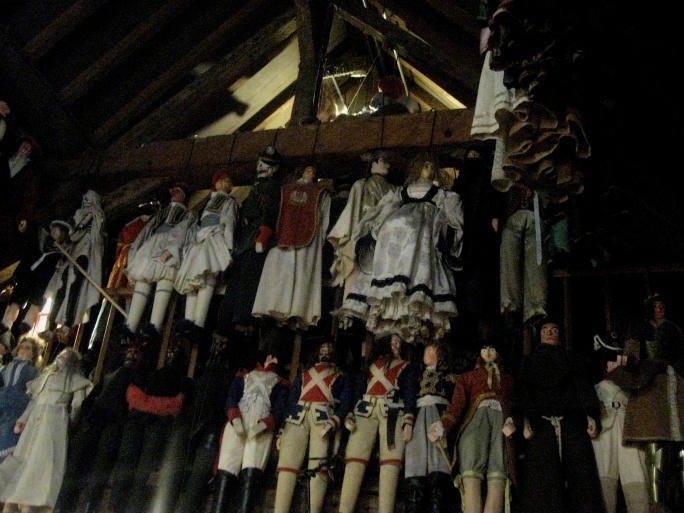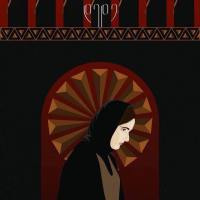Mascot and Toone VIII
Charleville-Mézières is in France on the Belgian border. My next stop was Brussels to find the Toone Marionnette Theatre, perhaps the oldest continuing puppetry organization in Europe. Yet I was on a train, then bus, then train again (don’t ask) on my way back to Paris with my back stressing load of belongings for another meeting. One of the people I had most wanted to connect with was madame Leona Beatrice Martin-Starewitch, the granddaughter of the first animated puppet (in fact dead bugs!) filmmaker Ladislas Starewitch, a Russian of Polish extraction, whose parents were from Lithuania. (Variously spelled Ladislaw Starevitch or Starewich, or Władysław Starewicz his birth name in Polish and even Владислав Старевич depending on the country. Since we are in France we’ll stay with the French orthography.) After the Russian Revolution Starewitch moved to Paris, less from political convictions than from the simple fact that Bolsheviks did not have the temperament to appreciate or support his sort of puppet films. Starewitch found success within a few years of his arrival in Paris and his home became a magnet for White Russian emigrés. Most of his great films were made in France: La Voix du Rossignol (The Voice of the Nightingale), Le Roman de Renard (The Tale of the Fox), Le Lion Devenu Vieux (The Old Lion) and especially the miraculous Fetiche Mascotte (The Mascot) from 1933.
Starewitch is a big influence on the Brothers Quay. When I mentioned him to Švankmajer, he immediately corrected my translator who was fumbling with the name a bit. Terry Gilliam also owes him a real debt and considers The Mascot as one of the ten greatest animated films made. Tim Burton’s animated work screams Starewitch. And Fetiche Mascotte seems like a direct ancestor of Toy Story. And if Wes Anderson did not make a careful study of Starewitch before making the Fantastic Mr. Fox. I’d be really surprised. Starewitch, like George Méliès, is one of those seminal figures, an original, an inventor, whose work is still literally marvelous!

The Stork Tyrant from Starewitch’s Frogland or The Frogs Demand King (Les Grenouilles qui Demandent un Roi) 1922
I made my way to a small café near the Bois de Vincennes to meet Madame Martin-Starewitch. I had tried several times to get in touch with her while in Paris, but alas schedules would not permit. And when she asked top meet me here two days after I had already left Paris I couldn’t turn her down. Fortunately the place was not overly crowded. I had just taken over a small booth with my three traveling packs and ordered a meal when she arrived, a bit early but that was fine with me. I still had to get to Brussels that evening.
We immediately began to talk. Her English was good enough to understand me thoroughly when I explained the nature of the project. The Brothers Quay had wondered if she remembered meeting them back in the 80’s at a conference in Annecy. She did indeed, and fondly. She was glad to know that their work owed such a debt to her grandfather. One of the first things she had told me was that they had recently found a longer version of Fetiche Mascotte that superseded all of the other versions. To puppet folk and animation fans this was good news indeed!
Also she told me that in addition to the four DVDs of Starewicz work currently available in France (with English subtitles, etc) there would be another four due to hit in the near future including one with the longest version of The Mascot. While she was the guardian of her grandfather’s legacy Starewitch is still hardly a household name. The one American DVD issued a while ago and now out of print was essentially a bootleg made without any funds ever returning to the estate. We both agreed that what was needed was a film like Hugo that made prominent use of Starewitch the way Scorsese had used Méliès. And she had stories of her grandfather that were certainly film worthy in themselves. All in all it was an excellent meeting with Madame Martin-Starewitch and she too was game for an interview and to use her grandfather’s work in Gravity From Above.
Now it was time to move on to get to Brussels. After passing through the Metro again, while sitting next to a hip young girl in a real fur coat (something you’d never see in America), listening to an entire string ensemble playing Baroque music at the busy Châtelet stop and paying an extra hundred dollars to get a train to Brussels, thanks again to the disconnect between the rail passes and life on the ground, I arrived, my back demanding rest in a rather industrial hotel near the old center of Brussels at around 21h00. Unfortunately my current information on the Toone had said that they had performed that day but were not to play again for a few more days. Had I come straight from Charleville without the extra stop I would have made it! But that Parisian meeting was very important.
I then strolled Bruxelles in the dark, passing the central cathedral bathed in purple light, and locating Le Théâtre Royal de Toone all the while slowly savoring a couple of Belgian chocolates. The next day, after sleeping in to give my aching muscles a rest, I wandered through the old town under a light rain. I stopped into to see if I could glean anything from restaurant that was also a part of the Toone theatre and it turned out that they were indeed playing that night! So much for relying on websites as some sort of final word…

Puppets Hanging in the Rafters at the Toone Theatre. (Note the Nazi Skeleton Puppet – Top Row Center)
I drifted around the town, found some old record stores, though sadly left the wares in their bins by command of my spine. That evening I entered the Toone restaurant again to wait for the theatre upstairs to open. The show for the evening was Romeo and Juliet á la Toone. Eventually the Royal Toone VIII himself, Nicolas Géal arrived in buoyant spirits to open the door to the stairs for us. Géal is the son of Toone José Géal, an important puppeteer in his own right who bequeathed the theatre to Nicolas back in 2003 in a coronation ceremony by the town Burgomaster. (Toone is pronounced ‘tone’ and a Belgian nickname for the original Toone I, Antoine Genty, who started the theatre a few years back in 1830.)
An eager throng ascended, passing old Toone posters, including the Passion play of the legendary modern playwright and puppet enthusiast Michel de Ghelderode. In the theatre itself we sat beneath over a hundred figures, each about one third human scale, that were hanging from the rafters high above us: such figures as Nazis with skulls for heads, Napoleon, knights in armor, many princesses and scores of variations on the classic Toone hero Woltje, a jaunty figure in checkered clothes and cap.
Eventually maximum density for the evening had been achieved and Toone VIII emerged to greet us to the evenings production of Romeo and Juliet. He then vanished behind a side curtain and the farce began in an outrageous nasal quacking French/Dutch dialect. Woltje plays Romeo. Juliet has the face of a doll. Mercutio is played by another classic Toone figure with a nose long enough to be sold by a hotdog vendor. In the middle of one scene, Romeo is distracted by a cellphone call. Obviously it’s not exactly word for word Shakespeare. But it certainly is amusing.
During the intermission Nicolas Géal invites us all down to the ‘museum’, which does have quite a few battered antique characters on the wall, but really this is a chance to down a bit of another Belgian specialty, beer, which I must confess is an excellent way to spend the halftime. After about twenty minutes we then watched the rest of the show, which being a comedy does not exactly have the same ending as the Shakespearean tragedy. Death comes for Romeo and Juliet, but seconds before he can take the dead puppets is unceremoniously booted off stage my the monk.
After the show I spent a while talking with Géal about Toone history. I reminded him of a strange story of one of the Toone marionettists who was found dead hanging among his puppets. To confirm the fact, he showed me a book that his mother wrote back in the 70’s about the history of the Toone theatre, complete with oodles of illustrations. It’s a book I determined to track down some day. He also explained something about the weird Brussels accent that used to be Dutch with some French but over the years had become French with some Dutch. Géal was delighted to have Toone performances captured when I returned for part two of this journey next year. And I was pleased to have another solid contact for the future.
And I can also gladly say when in Belgium do not miss Le Théâtre Royal de Toone. Tell Toone VIII that you heard about it from me. It doesn’t matter what language you speak. You’re in Brussels, a place where language is so polyglot that your original tongue doesn’t matter to anyone. (Still, at least try to learn a few French greetings.)
Next we cross La Manche to enter Angleterre.
Byrne Power
Haines, Alaska
December 22, 2012
For more information on Starewitch go here:
http://ls.pagesperso-orange.fr/tsommair.htm
And to discover Le Théâtre Royal de Toone try this:











Pingback: Marionette Dynasties in Brussels Part 2 | GRAVITY FROM ABOVE
Pingback: Avec les Bruxelloises | GRAVITY FROM ABOVE
Pingback: Opera Dei Pupi In Palermo | GRAVITY FROM ABOVE